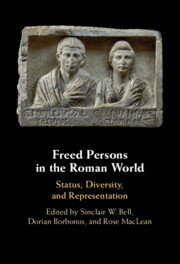Book contents
- Freed Persons in the Roman World
- Freed Persons in the Roman World
- Copyright page
- Contents
- Figures
- Table
- Contributors
- Acknowledgments
- Bibliographical Note
- Introduction
- 1 Permissu decurionum
- 2 Freed Public Slaves in Roman Italy and the Western Provinces
- 3 Fitting in by Decree
- 4 Doubling Up
- 5 The Cost of Ingratitude
- 6 Between Moral Slavery and Legal Freedom
- 7 Framing the Freed Person
- 8 Novel Evidence for Ancient Freed People
- 9 The Affects of Manumission
- General Bibliography
- Index
- References
3 - Fitting in by Decree
Freed Slaves, Euergetism, and Local Politics*
Published online by Cambridge University Press: 16 May 2024
- Freed Persons in the Roman World
- Freed Persons in the Roman World
- Copyright page
- Contents
- Figures
- Table
- Contributors
- Acknowledgments
- Bibliographical Note
- Introduction
- 1 Permissu decurionum
- 2 Freed Public Slaves in Roman Italy and the Western Provinces
- 3 Fitting in by Decree
- 4 Doubling Up
- 5 The Cost of Ingratitude
- 6 Between Moral Slavery and Legal Freedom
- 7 Framing the Freed Person
- 8 Novel Evidence for Ancient Freed People
- 9 The Affects of Manumission
- General Bibliography
- Index
- References
Summary
This chapter analyzes a number of municipal decrees and honorary inscriptions from Campania which can be dated to the second century CE. In these texts freed persons receive honors and privileges as a reward for their benefactions towards the community. The phenomenon itself is not surprising, but most acts of generosity by freed persons were done in their capacity as Augustales. In all cases discussed in this chapter the benefactions were done on a voluntary basis after negotiations with representatives of the city’s main political bodies. The most striking aspect of these texts is the language in which the benefactors are praised. They are heralded as role models whose behavior should be imitated by their fellow-citizens and their acts of generosity are praised as contributions to the political landscape. The benefactors provide a service to the community which corresponds to the standing of the city. While these texts may not prove that freed persons at the municipal level were consistently viewed in a positive light, a case can be made that at least some of them were regarded as valued members of the community. This evidence can then be used to broaden our perspective on the integration of freed persons in Roman society.
Keywords
- Type
- Chapter
- Information
- Freed Persons in the Roman WorldStatus, Diversity, and Representation, pp. 86 - 118Publisher: Cambridge University PressPrint publication year: 2024

